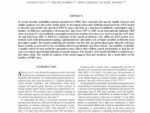Modeling Pneumococcal Resistance to Penicillin in Southern Sweden Using Artificial Neural Networks
In recent decades, penicillin-resistant pneumococci (PRP) have emerged and spread rapidly between and within countries over the world. In this study we developed an iterative artificial neural network (ANN) model to describe and predict the spread of PRP in space and time as a function of antibiotic consumption and a number of different confounders. Retrospective data from 1997 to 2000 on an international epidemic PRP clone (serotype 9V) and antibiotic consumption data from Southern Sweden were used to train the ANN models and data from 2001 to 2003 for evaluation of the model predictions. Five different ANN models were trained, each with independent topology optimization for alternative sets of input variables to find the most descriptive model. The model containing all variables was the only one performing better than the reference linear models, as assessed by the correlation between predictions and observations. The inability to identify a smaller subset of most predictive parameters may reflect either diffuse causal mechanisms or just the absence of critical experimental indicators from the dataset. The iterative ANN model identified is useful to predict future data. The sensitivity analysis of the model suggests that past incidence has a small effect on the number of PRP cases.
